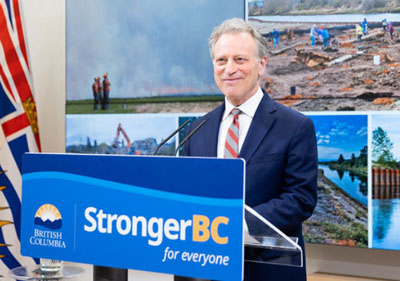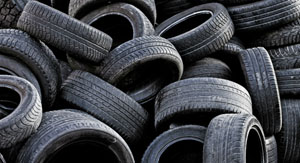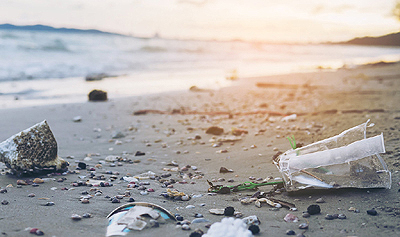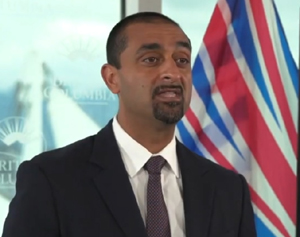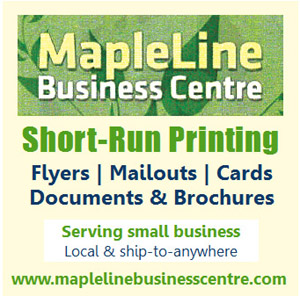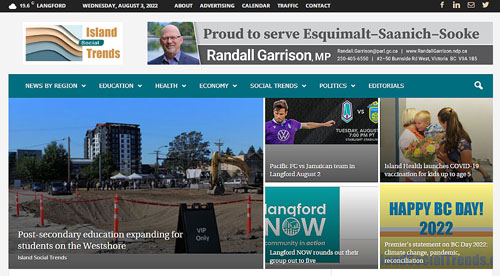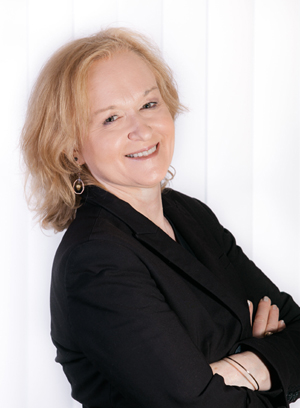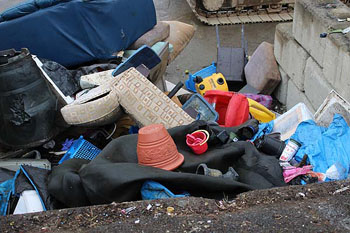
Tuesday August 9, 2022 | VANCOUVER ISLAND, BC [Updated August 10, 2022]
by Mary P Brooke | Island Social Trends
A $10-million investment in the CleanBC Plastics Action Fund will help grow made-in-BC solutions to reduce plastic pollution, create new products and increase job opportunities. The funds are part of Budget 2022.
Calling it a CleanBC announcement together with StrongerBC, today’s media session in Delta was made together by Minister of Jobs, Economic Recovery and Innovation Minister Ravi Kahlon (MLA for Delta North) together with George Heyman, Minister of Environment and Climate Change Strategy.
Recycling manufacturers:
Also speaking today at the government announcement event in Delta were executive leads from two plastics recycling companies — Clark Chow, president of Plascon Plastics, and Kevin Andrews, VP Operations at Merlin Plastics.
Those two companies have received support through CleanBC in previous funding rounds.
Plascon Plastics: With about 50 employees, Plascon Plastics based in Delta started their business in 2017 with injection molding, finding ways to make products out of waste stream materials. That includes recycled vehicle tires, plastics from electric vehicle batteries, and collected ocean plastics.
Today their president highlighted a recent project whereby child-resistant plastic wrap is made for Canadian cannabis product packaging. They have also produced packaging for cosmetics and easy-coffee products.
Innovation with a range of “inconsistent” types of plastic materials is part of their company’s challenge. To further achieve in this area they invest in tooling and prototyping.
Merlin Plastics: Now into their 35th year, Merlin Plastics in Delta employs 400 people (100 of those in BC) and processes one million pounds of plastic per day as the company makes resin out of post-consumer and post-industrial scrap, said Andrews. They work with brand owners, retailers, and industry associations to improve packaging design for recyclability as well as develop alternatives for ongoing sustainable solutions in the circular economy.

They recycle film, grocery bags, rigid plastics such as blue boxes and shampoo bottles, polypropylene tubs and lids, polyethylene terephthalate (PET) pop and water bottles, and more. Minister Heyman has toured their sorting facility and their processing plant, said Andrews today.
The largest plastics processor in Canada, Merlin Plastics uses bottles and other plastics retrieved from rivers. They have seven facilities in North America including two in BC, two in Alberta, one in Ontario, one in Oregon, and one in California.
Reducing land and water pollution:
“By reducing plastic waste at the source through systems that reuse items and by including more recycled material in the manufacturing of products, our government is helping keep more plastics out of landfills and ecosystems, creating a better future for all of us while growing the circular economy.”
However, Heyman said today that plastics “are part of our economic life and daily life”, in response to Island Social Trends asking about the supply availability for current and future projects that will rely on sourcing second-hand plastics.
Heyman calls that supply ‘feedstock’. He says that two-thirds of plastics collected from shoreline cleanup projects gets “out of the environment” and is “upcycled or recycled”.
BC is a leader in extended producer responsibility (EPR) recycling and has more EPR programs than any other jurisdiction in North America.
Already captured annually in BC’s EPR programs are 315,000 tonnes of plastics, such as those in electronics, beverage containers and other packaging.
The Clean Coast, Clean Waters initiative has cleaned nearly 4,000 kilometres of shoreline, removed more than 1,000 tonnes of debris and recycled or upcycled 65% of recovered material.
Recipient projects aimed at reducing, reusing:
As part of Budget 2022, the Province is dedicating nearly $10 million to fund projects that will reduce the use of new plastic, expand reuse of plastics, and increase the use of post-consumer recycled plastic. This second intake of the Plastics Action Fund includes dedicated funding for businesses that are developing systems for reuse, and Indigenous-led projects.
This builds upon the nearly $5 million distributed in 2021 to nine projects through the first intake of the CleanBC Plastics Action Fund, which increased B.C.’s capacity to process and use recycled plastic by 20,000 tonnes per year.
“When we support and discover innovative ways to reduce, reuse and recycle plastics, we are creating clean growth opportunities in our province,” said Kahlon. “It’s great to see innovative local companies supporting good jobs for people in the clean economy and reducing our impact on the planet, helping to build a stronger B.C. for everyone.”
Relying on consumers:
“British Columbians deeply value our environment, and we all want to find solutions to keep plastics from polluting our lands and waterways,” said Minister Heyman.
Reliance on consumers doing their curbside recycling is key, said Andrews today in response to a question by Island Social Trends. Anything that gets collected at the curbside and through bottle depots goes “almost directly” into the recycling processing system, he said.
“Source separation of recyclable materials is critical to ensure that plastics are processed and recycled through end markets,” says Russ Smith, Senior Manager, Environmental Resource Management, CRD.
By contrast, if plastics are put by consumers into the garbage (which heads for landfills), it’s unlikely to be sorted and sent on to manufacturers of recycled products, Andrews stated.
“Plastics that arrive at the landfill through the mixed refuse stream (household garbage and industrial and commercial waste) cannot be diverted for a number of operational reasons, including the safety of facility staff,” says Smith.
In the Greater Victoria area, recycling collection by the Capital Regional District (CRD) on behalf of Recycle BC is conducted through curbside, multi-family dwelling and depot collection programs, says Smith. He adds that plastics collected through both curbside recycling and the recycling depot at Hartland Landfill are managed through Recycle BC.
The 5R’s at CRD are Reduce, Reuse, Recycle, Resource Recovery and Residuals Management. Resources used to create products are lost forever when items are thrown in the garbage, says CRD. By participating in recycling programs people are taking responsibility for the products purchased by consumers. CRD encourages people to support the system where these materials can be used over and over again.
Out in the Sooke area, long-time resident Al Wickheim says: “When you recycle thoroughly there is very little actual landfill material. Even soft plastics and styrofoam, meat trays and cellophane — clean it and take down to the depot on Marilyn Road off Sooke River Road. Costs 5 bucks but do it anyway, you’ll feel better for it, rather than all that packing material end such filling up Hartland.”
New areas of focus:
The Province is phasing in the recycling of new waste products, including electric-vehicle batteries, mattresses, compressed-gas canisters and medical sharps (e.g., hypodermic needles) through the Extended Producer Responsibility Five-Year Plan.

Heyman emphasized mattress recycling as something BC really wants to do.
He noted the achievement of the BC government in changing legislation so that municipalities wouldn’t need to get provincial approval for single-use plastic bans if they had consulted with people in their jurisdictions.
Applications open Sept 2022 to Feb 2023:
BC-based projects will be selected for the second funding intake based on their ability to reduce the use of new plastic or increase the use of post-consumer recycled plastic.
Interested applicants can apply online, with successful projects being chosen beginning in late September and continuing until February 2023. All projects must be complete by February 15, 2024.
Applications are screened by a third party called the Alacrity Foundation, said Minister Kahlon today. Alacrity Foundation operates the Alacrity BC CleanTech Initiative.
About the fund:
The first phase of the CleanBC Plastics Action Fund saw projects receive funds in the $20,000 to $30,000 range while others received up to a million dollars, said Kahlon today. The key things looked for in applications are “viability, value and new opportunities”, the Innovation minister said.
The fund is an important part of the CleanBC Plastics Action Plan’s goal of reducing plastic pollution through reuse and the use of recycled plastic. Other BC government actions from the plan include supporting municipal bans on single-use plastics, expanding producer-funded recycling programs and funding the largest shoreline cleanup of ocean plastics in provincial history through the Clean Coast, Clean Waters initiative.
===== ABOUT ISLAND SOCIAL TRENDS:
Island Social Trends has been publishing socioeconomic news insights since 2008 (first as MapleLine Magazine 2008-2010, then Sooke Voice News 2011-2013, then West Shore Voice News 2014-2020), launching fully online at islandsocialtrends.ca in mid-2020.
Founding editor and publisher for that entire series of publications is Mary P Brooke, B.Sc., Cert PR. She holds the McGeachy Prize in Journalism from the English Department at the University of Saskatchewan.
Island Social Trends news insights include environmental and sustainability issues as well as agriculture and food sustainability.



